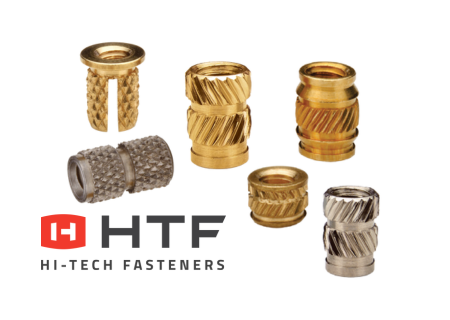The experts at HTF are here to help you find the right threaded insert for your application. Finding the part you need is a breeze if you know the right questions to ask. HTF carries a large inventory of threaded inserts, so there will surely be one to match your needs.
Threaded inserts are necessary for applications requiring threads in a host material. They are critical when frequent assembly and disassembly are required.
The benefit of using a metal insert in a plastic host material is added durability and strength. You can achieve this by matching the proper insert and installation method to the host material and application. How do you decide which threaded insert is suitable for your application? The best way to determine this is to ask four questions:
- What type of insert is right for my application?
- What size threaded insert do I need?
- How do I install the threaded insert?
- How do I get the best price for my threaded inserts?
Let’s explore these four questions in greater detail to help determine the best-threaded insert for the job.
Four Questions to Ask When Buying Threaded Inserts
1. What Type of Insert Is Right for My Application?
There are several choices for material when it comes to choosing your threaded inserts. Threaded inserts are often made of brass, but aluminum and stainless steel options also exist. The benefit of these alternatives includes having a lead-free option. The host materials for threaded inserts are typically thermoset plastics or thermoplastics.
The threaded inserts' material makes them sturdy, long-lasting, and resistant to corrosion. They are best paired with plastic or soft wood applications. The stainless steel and aluminum threaded inserts are better at meeting sustainability regulations, and both are more effective than brass, with greater strength and less weight.
2. What Size Threaded Insert Do I Need?
Another consideration when choosing the proper threaded insert for your application is the size of the insert—standard threaded inserts for plastics range from ⅛-9/16” in diameter to ⅛-⅝” in length. Thread sizes range from #0-80 to ⅜-16. The extensive size range means the right threaded insert for any application is available, including industries like electronics, automotive, aerospace, defense, medical, industrial, and recreational equipment.
3. How Do I Install a Threaded Insert?
Heat-Staking insertion is for thermoplastic use only. It involves the insert being heated with a thermal press until it melts a small part of the hole’s edges while being pushed into the thermoplastic assembly. The melted resin then seeps and fills the knurl pattern to form a firm bond when hardened.
Ultrasonic Assisted threaded inserts are used in thermoplastics only and are designed to melt the surrounding hole. The difference is that Ultrasonic melts the entire hole, and heat-staking melts the edge.
Molded-In threaded inserts ensure the best pullout and torque performance. It involves machine-directed insertions into the mold; the resin is added to encase the insert, creating a solid bond.
Cold Pressed-In with thermosets is the easiest and least costly plastic insertion method. It requires a basic press for installation. The inserts are simply pressed into the thermoset plastic mold. It has a weaker bond and overall strength but generally is a sturdy alternative and saves costs.
The inserts are installed with different presses, some using heat and others that do not require heat. The heat presses create a stronger bond but are more expensive.
4. How Do I Get the Best Price for Threaded Inserts?
The material, size, and installation method will determine the cost of the threaded insert you need. Cold pressed-in inserts will be more affordable than the molded-in threaded inserts installed with heat and then have resin added that encases the insert. To compare pricing on the different insert options, you can look through HTF’s inventory catalog and consult with the experts at HTF. If you need a large order, bulk discounts are available through HTF.
HTF Delivers Affordable Solutions
When choosing the right threaded inserts for your application, it is essential to consider the material, size, installation, and price to make the best choice. Threaded inserts are an excellent choice for their affordability, pullout, and torque performance. They are best used in plastics that require frequent assembly and disassembly. Request a quote to find your application's best-threaded insert and learn more about our bulk pricing.









